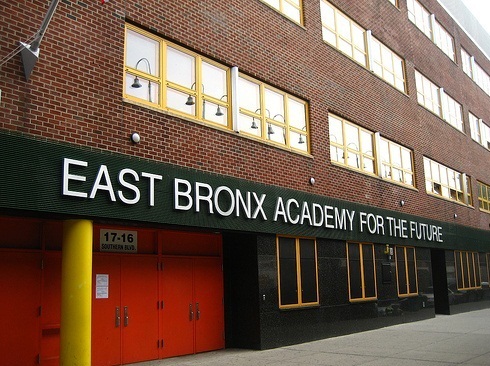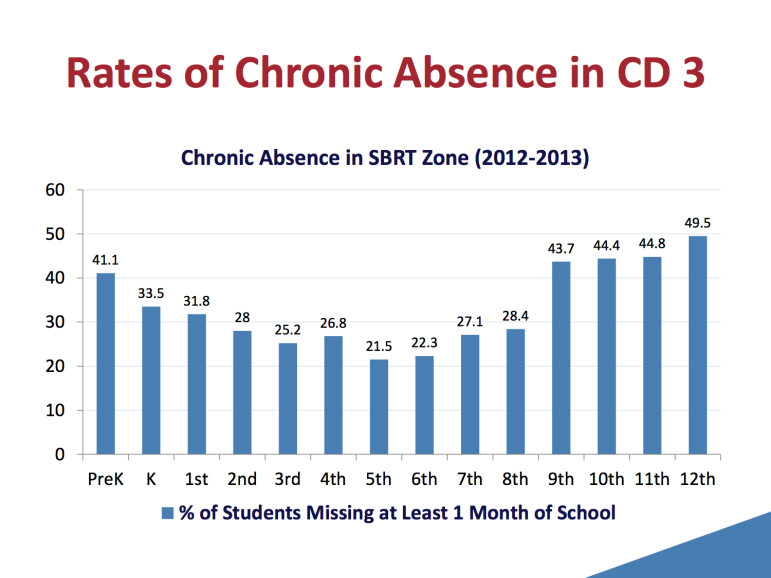
DOENYC
The problem of chronic absenteeism tends to spike in the early grades (with pre-Kindergarteners and Kindergarteners missing the most days) and then again in high school.
No shoes, scared of school, sick or taking care of younger children – the reason students miss school can be multiple, but the total adds up to the same thing. One in three children in the South Bronx misses a month of school every year.
With 61 schools spread across the South Bronx, including large parts of school district 9, part of school district 12 and part of school district 8, that is a lot of children going missing from class.
Hoping to leverage work begun under the Bloomberg administration and building on Mayor Bill de Blasio’s financial support for community schools, a coalition of community-based organizations, South Bronx Rising Together, has banded together to tackle a host of issues preventing families from thriving in the Bronx.
“We are tired of working in silos,” said Abelardo Fernandez, co-director of SBRT and director of collective impact at the Children’s Aid Society, a founding member of SBRT. “Let’s work better by working together.”
Kicking off an attendance awareness campaign the last week in September (and marking September officially as attendance awareness month) parents, principals, students, politicians and advocates came together at East Bronx Academy on Southern Blvd and 174th Street last Monday night to celebrate SBRT’s new initiative to pair 12 struggling schools with community-based organizations. Five of the partnerships are already up and running.
The idea is to “correlate” services, so schools will not only find out why children aren’t coming to school, but also be able to help solve the underlying issues of chronic absenteeism.
Chronic absenteeism is defined as missing 10 percent or more of school over the course of a school year, as either excused or unexcused absences — effectively, missing 18 days, which represents a month of school. According to data from the Center for New York City Affairs at the New School, in the 2012-2013 school year, the average number of children in Community District 3 who were chronically absent was 35.5 percent – with the percentage spiking over 40 percent for the children in the youngest and highest grades.
Nationwide, the average is 1 in 10.
While most schools only pay attention to the average daily attendance – the percentage of children who show up each day to school – and unexcused absences, both figures can mask the problem of chronic absenteeism, according to the national initiative Attendance Works.

2012-13 data compiled by the Center for New York City Affairs at the New School
From data that was first gathered by a Bloomberg task force, supported with work from the Center for New York City Affairs, advocates have known for awhile that chronic absence is one of the most powerful indicators that children will not be on track for reading in elementary school or credit accumulation, in high school. It further leads to other negative outcomes, advocates said, including increased levels of high-school drop-out rates and greater levels of social problems such as substance abuse.
And all the educational initiatives available won’t work if children aren’t showing up regularly for school, advocates observed.
“It’s not just about the kids, it’s about the family,” said Fernandez. This is really that “parents understand the decisions they make every day for five-, six-, and four-year-olds, those every-day decisions add up.”
The problem of chronic absenteeism tends to spike in the early grades (with pre-Kindergarteners and Kindergarteners missing the most days) and then again in high school, for reasons including homelessness, not having the right clothes, illness, being afraid to walk to school or being afraid in school, boredom with classwork, having to take care of younger siblings.
According to Attendance Works, by 6th grade, absenteeism is one of three signs that a student may drop out of high school, and by 9th grade, regular and high attendance is a better predictor of graduation rates than 8th grade test scores. Absenteeism can hide in plain site: students missing a day or two of school every few weeks end up being chronically absent.
Learning how to more closely read her attendance data has been an eye opener for elementary-school principal Lucia Orduz-Castillo, now three years into her job at the helm of PS 42. Going over her students’ results on the state exams from last spring, a disheartening number of them failed the tests, she said, with only 8 percent getting a score of 3 or 4. Then she cross-correlated those scores with absentee rates. One child, who was absent 64 days last year, had scored a 2.7 on the state ELA tests. Imagine, she said, what the score could have been if the child was a regular, attending student.
“Attendance is complex,” said Orduz-Castillo. “It’s about motivating kids, motivating parents and training staff how to be responsive to the children’s needs. If children are engaged, they are more likely to come to school.”
The focus on attendance in the South Bronx connects with a broad de Blasio administration focus on so-called community schools, which are supposed to provide support not just for a student’s education but also for her social, health and emotional needs.
At the start of September, the mayor announced 130 new community schools. The South Bronx will see its number go from 9 to 20. Some of the community schools already existed and were being funded during the Bloomberg years by the Children’s Aid Society, said Fernandez.
While many community schools are already partnering with community-based organizations to help provide additional services to families, as well as grapple with the issue of attendance, the SRBT initiative provides schools with an expanded access to community stakeholders – hospitals, health clinics, NYCHA officials, DOE officials, nonprofits that focus on developing jobs for youth in the tech sector – to leverage the needs of many schools, rather than solving issues on a school-by-school basis, said Fernandez.
“I think we are adding value to this work by creating a regional support for those schools,” said Fernandez: “some challenges go beyond what a community school can solve. We want to hear what those are and connect the right systemic partners.”
Chronic absenteeism affects everyone in the school – from the children who are absent, excused or not, to the children who do come but have to wait while teachers get their peers up to speed on work missed, said Fernandez.
SBRT will assist schools in concrete ways: helping principals understand how to access the data they already have on attendance to drill down on who is not coming to school and way, and then partnering with CBOs to help solve the reasons for nonattendance.
Fernandez believes the whole community of the South Bronx needs to take leadership and responsibility for ensuring all children come to school: The more often children come to school, the more they learn, the greater the chances they will be on track to read on the correct level, graduate and move forward with their lives.
Patricia Quigley, principal of PS 61, who has partnered with a CBO to improve attendance, said schools and parents and community partners need to work together to make sure that children know the value of education and know that they belong in school. She added: “Children need to have purpose.”








